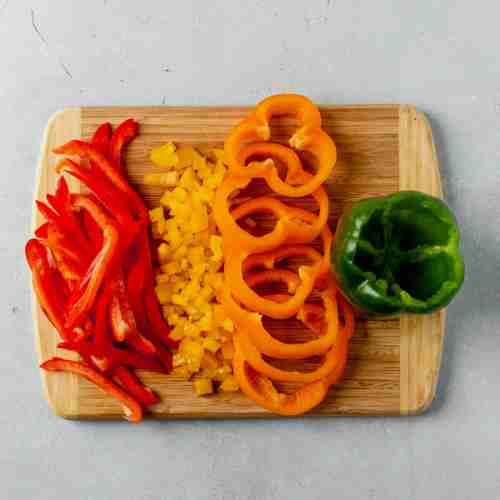Do you know how to cut an entire bell pepper and not waste all of it and not make a massive mess from the seeds? The method was taught to me by an experienced chef. It’s so simple!
Learn the best way to slice or dice your peppers to use in salads, dips, stir-fries, and much more.
grey chopping boards with red and green slices of bell pepper
In reality, the chef with experience who taught me the method for cutting up peppers… has actually been my husband. Maybe I’m a bit biased, but really this is the article I’ve wanted to publish for five years because it’s very exciting for me.
The way you cut a pepper will leave the seeds intact. This means you’ll no longer have seeds that stick to your fingers, the cutting board, your knife, or countertops in the kitchen… It’s a relief to know that I had a bad time cutting fresh, freshly cut peppers. This is now the fastest and most straightforward job ever!
The result is the lowest amount of waste, as you’ll only throw away seeds and stem. The less waste you will have in your compost bin, which means less funds.
The method is simple and quick, so when you master this technique method, you’ll be more productive when it comes to cooking. Also, any time saved is always an advantage according to me.
5 Types of Bell Peppers

A major component of water bell peppers are renowned sources of vitamin C. They are available in wide varieties and colours.
The green bell peppers are:
Green bell peppers are among the ones with the least flavour and are mild because they’re picked from the vine prior to turning red and developing sweetness as they reach maturation.
Red bell peppers
Bell peppers with red colour are matured green peppers. They are crisp in their bite, have a sweet flavour, and, thanks to their vibrant hue, they will add an energetic pop to any food.
Bell peppers of orange:
This kind of pepper has a sweetness that is more fruity and sweet as opposed to green peppers. Red and yellow bell peppers can be used for grilling, and the orange varieties make tasty salads.
Bell peppers of yellow:
The bell pepper in yellow is an intense
Vitamin C is a good source of folate, niacin and vitamin C. They are great additions to chilli and gumbo.
Sweet peppers with a long, sweet rim:
Although bell peppers are known to look squat and round longer, sweet peppers can be described as a long thin, slender, and sweeter type. They have thicker skin and fewer seeds. It is easy to bisect and then fill them with your favourite ingredients with a delicious stuffed pepper dish.
HOW TO SELECT BELL PEPPERS
Before we begin chopping it, I’d like to discuss how to pick the top bell peppers. Also, I’ll eliminate a popular myth regarding bell peppers. They are versatile and diverse vegetables.
When it comes to cooking, the use of high-quality ingredients will affect not just the taste of the food but also its appearance. Therefore, being competent enough to recognize and pick the finest quality ingredients is an important ability to possess.
No matter where you buy the peppers (or perhaps you’re picking your own from your backyard! ), You should pick peppers that have the following:
- The hand is firm and feels heavy in the palm
Smooth and with as few imperfections or soft spots as you can.
Fully matured, with a vivid full-grown colour - Peppers with wrinkles, soft spots, or any other flaws could indicate that the pepper is aging and in the process of decomposing, improperly handled during transportation or may be infected by the mould of some sort or other ailment (especially when mould or marks are black).
- Selecting the right pepper based on the number of bumps with the intention of deciding the right one for you is an untruth and isn’t really a fact like some online content may lead you to be led to believe.
How To Cut Bell Peppers

Given how adaptable this veggie can be, you’re going to need to learn how to slice bell peppers. If you’re cutting them in dice or juliennes, you’ll need to first ensure your knife is razor-sharp! Choose one of these methods depending on the dish you’re creating:
HALVES
The bottom is dependent on the pepper; it is possible to like to slice it lengthwise or cut off the top. If the pepper doesn’t hold up, flip it over and cut it into the length in half. Scrape the seeds with the help of your hands, a knife or a spoon. It is possible to remove the stems, and they’ll in keeping the contents from leaking out.
If the pepper’s bottom is straight, cut an inch off the stem’s end. Then move around the edges using an ice pick to cut the veins and seeds. Take the seeds out using your hands.
Roast the bell pepper halves of a red Or stuff any other colour using a range of fillings!
RINGS:
Place the bell pepper over on its side and cut off the stem, and then trim the stem end off again. Cut along the inner edges at the point where veins join the flesh. Then, pull away the seeds and veins with your fingers. The pepper should be tapped on the upside to rid it of any seeds that may be smuggled around.
Take the pepper in your hands using your hands that are not dominant, and cut it into rings beginning from the stem’s end. You can enjoy the top end of the pepper as a snack or keep it to make homemade vegetable stock. Cut the rings as long or thinly as you’d prefer. The pepper rings make a wonderful option for veggie sandwiches!
Julienne:
The stem ends up, and you can chop the bell pepper into equal pieces. The stems and seeds. For julienned sweet peppers, slice each quarter into thin strips. Set your bell peppers on the table with their skin side down. Place the edge of the knife on the highest point of your pepper. Slice straight down, creating a small (one-eighth of an inch) pepper strip. Repeat the process until you have thick, thin strips of bell peppers that you can later use to make a julienne vegetable salad or to garnish the food.
Dice:
The stem end of the pepper is down; cut the bell pepper into four equal pieces. Then, discard the seeds and stem. Cut each piece into small slices (about 1/4 or 1/2 one inch in width). Next, put your slices, then turn them into long lengths, then dice your peppers using a rocking motion that moves the knife in a circular motion. By using the dominant hand, you pull the pepper slices towards the blade with the other hand. It is possible to use the tiny, square-shaped diced peppers as dips, gumbos or as use them to garnish.
NOTES
Storage: Place the chopped bell peppers in an airtight container for at least three days. It’s helpful to cover the container with tissue paper to soak up any water.
Instructions for Freezing: Chop them to the desired size, and then freeze them in flash-on sheets and then store them in a safe, airtight freezer container. They’ll last up to 6 months.